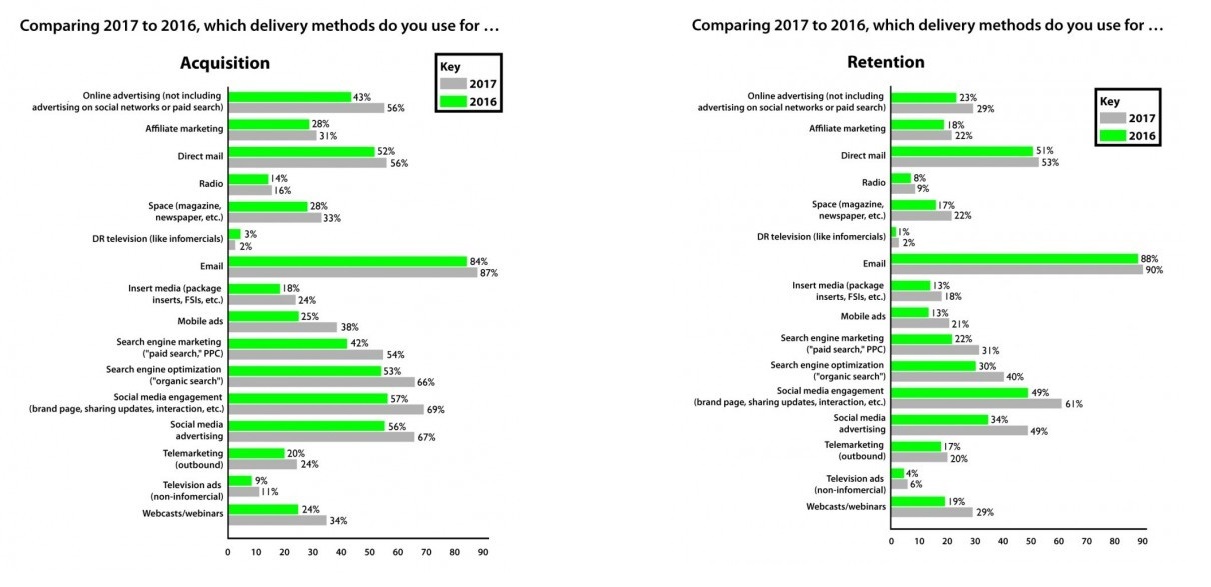Thankfully, owing to the different channels available for marketers to reach out to their target audience, they can analyze the performance of each channel and improvise their marketing strategies accordingly. While ROI is the prima facto for analyzing the performance, it indirectly depends on how well you managed to acquire your customers and how well you retain them.
As per a survey done in 2017 by Targetmarketing, email was observed to be the most preferred source for both. Interestingly, online advertising has seen a substantial growth in acquiring new customers (i.e. from 43% in 2016 to 56% in 2017).

How online advertising can benefit email marketing
What if we managed to combine the customer acquisition ability of online advertising with the already sky-rocketing statistics of email? Would it help create a better customer journey ending in better conversions? Let’s check out.
The global availability of internet means while everyone may not have an email address, they surely access popular websites on a daily basis. This means, while you need the email address of your lead to send an email, an online ad is easily viewable by your prospect on a website that they are currently browsing without you needing to collect any data of them beforehand. Moreover, the overall reach of a display ad, strategically placed on a website, has a greater chance of reaching your audience than a cold email sent to a prospect. Online advertising can help the email marketing realm in the following three ways:
- List Growth: By displaying ads to prompt the viewer to subscribe to your email newsletters is the most prime application of online ads. You begin with identifying your target audience, building your customer persona based on common interests, provide an alluring incentive in your ad and BOOM! Your ads are displayed on webpages that your potential subscribers are visiting. Based on whether your ad copy resonates with their pain point and the incentive is a solution that they are looking for, you receive the email address of those prospects.In fact, Time Magazine used 9 banner ads based on the devices used to visit their website to generate email leads. The results were great as the CTR of the displayed banners went from 0.01$ to 0.08% all traffic.
- Campaign-specific tone: Online ads have an advantage of being customized based on age, sex, location and behavioral By amalgamating your subscribers’ email addresses with the stored cookies, you can monitor the kind of ads the subscribers engage with and customize the email message tone for better engagements.
- Setting email sending time based on ad viewing: Every email marketer has looked for the optimal sending time for ensuring maximum open rates before realizing that there is no specific sending time that is one-size-fits-all. Based on the time when you get maximum clicks on your display banner in a specific geographic zone, you can have an estimated time window when your subscribers might open your emails. Although this might not pin-point the best time for sending an email, with trial and error, you can experiment.
How email marketing can benefit online advertising
An average person is served around 1700 banner ads per month yet 85% of display ads clicked are by 8% of internet users. This means that:
- Your subscribers might not be getting relevant ads based on their purchase history.
- Your subscribers might be suffering from banner blindness owing to the high volume of ads on a different website they had visited.
Email marketing can be helpful in such cases by providing relevance based on the preferences of the subscribers. Email marketing can be the leverage for your online advertisements in the following scenarios:
- Increasing brand visibility: Online ads are displayed based on the search criteria which can be as broad as “Men” or “Men of 30-35 age” and as specific as “Men of 30-35 age from San Francisco Bay area looking for Hiking boots”. When you already have a buyer persona built purely from the online behavior of your subscribers, you can target your ads to only those prospects who come under your buyer persona. This way you tend to use your existing emailing list to identify and target more such people and thereby increase your brand visibility.
- Retargeting ads: A rough adaptation of the conventional site retargeting, you can target email subscribers using email-based retargeting. Email retargeting depends on placing a tracking pixel or tracking cookie within the email body. Depending on which was the last email opened by your subscribers, you can display custom online banners and ads that serve as a reminder for the subscriber. This is especially useful in a situation where a subscriber has abandoned their cart and opened the relevant cart abandonment emails but not yet returned to their cart.
- Social media ads using email lists: Social media ads are where you build an audience segment based on their social interactions. The core advantage is that re-targeting options are already supported by social media platforms such as Facebook Custom Audiences, Twitter Tailored Audiences, Google’s Customer Match and LinkedIn’s Advertisers.
Wrapping Up:
Sometimes, the amount of boost you get from one marketing platform might not be sufficient and dabbling with two different platforms may consume a great deal of time to set up. However, the disadvantage of one platform being countered by the second one may work wonders in the longer run. Do you agree with the article above or not? Share your thoughts in the comments below.
_______
by Kevin George
Source: business2community.com









